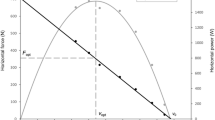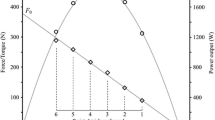Abstract
Purpose
This study explored the agreement between a single-run and a multiple-run method for force–velocity (Fv) profiling of sprinting athletes; we evaluated both absolute values and changes over time caused by sprint training.
Methods
Seventeen female handball players (23 ± 3 years, 177 ± 7 cm, 73 ± 6 kg) performed 30 m un-resisted and resisted sprints (50, 80 and 110 N resistance) before and after an 8-week sprint training intervention. Two approaches were used to calculate theoretical maximal velocity (v0), horizontal force (F0), power (Pmax), and the force–velocity slope (SFv): (1) the single-run method, based on inverse dynamics applied to the centre-of-mass movement, was calculated from anthropometric and sprint split time data; and (2) the multiple-run method, where peak velocity from un-resisted and resisted sprints were plotted against the horizontal resistances.
Results
Trivial differences in v0 (0.7%) were observed between the two calculation methods. Corresponding differences for F0, Pmax and SFv were 16.4, 15.6 and 17.6%, respectively (most likely; very large effect size). F0 showed poor agreement between the methods (r = 0.26 and 0.16 before and after the intervention). No substantial correlation between the changes (from pre- to post-training tests) in SFV calculated with the single-run and the multiple-run methods were observed (r = 0.02).
Conclusions
This study revealed poor agreement between the Fv relationships of the investigated calculation methods. In practice, both methods may have a purpose, but the single-run and the multiple-run methods appear to measure somewhat different sprint properties and cannot be used interchangeably.


Similar content being viewed by others
Change history
05 January 2019
The author would like to correct the errors in the publication of the original article. The corrected details are given below for your reading.
Abbreviations
- CI:
-
Confidence interval
- CoM:
-
Centre-of-mass
- CV:
-
Coefficient of variation
- ES:
-
Effect size
- F 0 :
-
Maximum theoretical horizontal force
- Fv:
-
Force–velocity
- P max :
-
Maximum horizontal power
- S Fv :
-
Slope of the linear force–velocity relationship
- TE:
-
Typical error
- v 0 :
-
Theoretical maximal velocity
- ∆ :
-
Change (delta)
References
Bezodis NE, Salo AI, Trewartha G (2014) Lower limb joint kinetics during the first stance phase in athletics sprinting: three elite athlete case studies. J Sports Sci 32:738–746. https://doi.org/10.1080/02640414.2013.849000
Bobbert MF (2012) Why is the force-velocity relationship in leg press tasks quasi-linear rather than hyperbolic? J Appl Physiol 112:1975–1983. https://doi.org/10.1152/japplphysiol.00787.2011
Colyer SL, Nagahara R, Salo AI (2018) Kinetic demands of sprinting shift across the acceleration phase: novel analysis of entire force waveforms. Scand J Med Sci Sports 28:1784–1792. https://doi.org/10.1111/sms.13093
Cormie P, McGuigan MR, Newton RU (2011) Developing maximal neuromuscular power: part 2—training considerations for improving maximal power production. Sports Med 41:125–146. https://doi.org/10.2165/11538500-000000000-00000
Cross MR, Brughelli M, Brown SR, Samozino P, Gill ND, Cronin JB, Morin JB (2015) Mechanical properties of sprinting in elite rugby union and rugby league. Int J Sports Physiol Perform 10:695–702. https://doi.org/10.1123/ijspp.2014-0151
Cross MR, Brughelli M, Samozino P, Morin JB (2017) Methods of power-force-velocity profiling during sprint running: a narrative review. Sports Med 47:1255–1269. https://doi.org/10.1007/s40279-016-0653-3
Cross MR, Samozino P, Brown SR, Morin JB (2018) A comparison between the force-velocity relationships of unloaded and sled-resisted sprinting: single vs. multiple trial methods. Eur J Appl Physiol 118:563–571. https://doi.org/10.1007/s00421-017-3796-5
Davies CT, Wemyss-Holden J, Young K (1984) Measurement of short term power output: comparison between cycling and jumping. Ergonomics 27:285–296
Dorn TW, Schache AG, Pandy MG (2012) Muscular strategy shift in human running: dependence of running speed on hip and ankle muscle performance. J Exp Biol 215:1944–1956. https://doi.org/10.1242/jeb.064527
Driss T, Vandewalle H (2013) The measurement of maximal (anaerobic) power output on a cycle ergometer: a critical review. Biomed Res Int 2013:589361. https://doi.org/10.1155/2013/589361
Fenn WO, Marsh BS (1935) Muscular force at different speeds of shortening. J Physiol 85:277–297. https://doi.org/10.1113/jphysiol.1935.sp003318
Hahn D, Herzog W, Schwirtz A (2014) Interdependence of torque, joint angle, angular velocity and muscle action during human multi-joint leg extension. Eur J Appl Physiol 114:1691–1702. https://doi.org/10.1007/s00421-014-2899-5
Haugen T, Buchheit M (2016) Sprint running performance monitoring: methodological and practical considerations. Sports Med 46:641–656. https://doi.org/10.1007/s40279-015-0446-0
Haugen T, Tønnessen E, Seiler S (2012) The difference is in the start: impact of timing and start procedure on sprint running performance. J Strength Cond Res 26:473–479. https://doi.org/10.1519/JSC.0b013e318226030b
Haugen TA, Breitschädel F, Samozino P (2018a) Power-force-velocity profiling of sprinting athletes: methodological and practical considerations when using timing gates. J Strength Cond Res. https://doi.org/10.1519/JSC.0000000000002890
Haugen T, Danielsen J, Alnes LO, McGhie D, Sandbakk Ø, Ettema G (2018b) On the importance of “Front-side mechanics” in athletics sprinting. Int J Sports Physiol Perform 13:420–427. https://doi.org/10.1123/ijspp.2016-0812
Hopkins WG, Batterham AM (2018) The vindication of magnitude-based inference. Sportscience 22:19–29
Hopkins WG, Marshall SW, Batterham AM, Hanin J (2009) Progressive statistics for studies in sports medicine and exercise science. Med Sci Sports Exerc 41:3–13. https://doi.org/10.1249/MSS.0b013e31818cb278
Huijing PA (1998) Muscle, the motor of movement: properties in function, experiment and modelling. J Electromyogr Kinesiol 8:61–77
Jaskólska A, Goossens P, Veenstra B, Jaskólski A, Skinner JS (1999) Comparison of treadmill and cycle ergometer measurements of force-velocity relationships and power output. Int J Sports Med 20:192–197
Lai A, Schache AG, Brown NA, Pandy MG (2016) Human ankle plantar flexor muscle-tendon mechanics and energetics during maximum acceleration sprinting. J R Soc Interface. https://doi.org/10.1098/rsif.2016.0391
Miller RH, Umberger BR, Caldwell GE (2012) Sensitivity of maximum sprinting speed to characteristic parameters of the muscle force-velocity relationship. J Biomech 45:1406–1413. https://doi.org/10.1016/j.jbiomech.2012.02.024
Morin JB, Samozino P (2016) Interpreting power-force-velocity profiles for individualized and specific training. Int J Sports Physiol Perform 11:267–272. https://doi.org/10.1123/ijspp.2015-0638
Morin JB, Samozino P (2017) Spreadsheet for sprint acceleration force-velocity-power profiling. ResearchGate. https://www.researchgate.net/publication/321767606_Spreadsheet_for_Sprint_acceleration_force-velocity-power_profiling
Morin JB, Edouard P, Samozino P (2011) Technical ability of force application as a determinant factor of sprint performance. Med Sci Sports Exerc 43:1680–1688. https://doi.org/10.1249/MSS.0b013e318216ea37
Morin JB, Bourdin M, Edouard P, Peyrot N, Samozino P, Lacour JR (2012) Mechanical determinants of 100-m sprint running performance. Eur J Appl Physiol 112:3921–3930. https://doi.org/10.1007/s00421-012-2379-8
Morin JB, Gimenez P, Edouard P, Arnal P, Jiménez-Reyes P, Samozino P, Brughelli M, Mendiguchia J (2015) Sprint acceleration mechanics: the major role of hamstrings in horizontal force production. Front Physiol 6:404. https://doi.org/10.3389/fphys.2015.00404
Nagahara R, Matsubayashi T, Matsuo A, Zushi K (2014) Kinematics of transition during human accelerated sprinting. Biol Open 3:689–699. https://doi.org/10.1242/bio.20148284
Nagahara R, Mizutani M, Matsuo A, Kanehisa H, Fukunaga T (2018) Association of sprint performance with ground reaction forces during acceleration and maximal speed phases in a single sprint. J Appl Biomech 34:104–110. https://doi.org/10.1123/jab.2016-0356
Petrakos G, Morin JB, Egan B (2016) Resisted sled sprint training to improve sprint performance: a systematic review. Sports Med 46:381–400. https://doi.org/10.1007/s40279-015-0422-8
Rabita G, Dorel S, Slawinski J, Saez-de-Villarreal E, Couturier A, Samozino P, Morin JB (2015) Sprint mechanics in world-class athletes: a new insight into the limits of human locomotion. Scand J Med Sci Sports 25:583–594. https://doi.org/10.1111/sms.12389
Rahmani A, Viale F, Dalleau G, Lacour JR (2001) Force/velocity and power/velocity relationships in squat exercise. Eur J Appl Physiol 84:227–232
Rakovic E, Paulsen G, Helland C, Eriksrud O, Haugen T (2018) The effect of individualised sprint training in elite female team sport athletes: a pilot study. J Sports Sci 9:1–7. https://doi.org/10.1080/02640414.2018.1474536
Sale DG (2002) Postactivation potentiation: role in human performance. Exerc Sport Sci Rev 30:138–143
Samozino P, Morin JB, Hintzy F, Belli A (2008) A simple method for measuring force, velocity and power output during squat jump. J Biomech; 41:2940–2945. https://doi.org/10.1016/j.jbiomech.2008.07.028
Samozino P, Rejc E, Di Prampero PE, Belli A, Morin JB (2012) Optimal force-velocity profile in ballistic movements—altius: citius or fortius? Med Sci Sports Exerc 44:313–322. https://doi.org/10.1249/MSS.0b013e31822d757a
Samozino P, Rabita G, Dorel S, Slawinski J, Peyrot N, Saez de Villarreal E, Morin JB (2016) A simple method for measuring power, force, velocity properties, and mechanical effectiveness in sprint running. Scand J Med Sci Sports 26:648–658. https://doi.org/10.1111/sms.12490
Schache AG, Dorn TW, Williams GP, Brown NA, Pandy MG (2014) Lower-limb muscular strategies for increasing running speed. J Orthop Sports Phys Ther 44:813–824. https://doi.org/10.2519/jospt.2014.5433
Slawinski J, Termoz N, Rabita G, Guilhem G, Dorel S, Morin JB, Samozino P (2017) How 100-m event analyses improve our understanding of world-class men’s and women’s sprint performance. Scand J Med Sci Sports 27:45–54. https://doi.org/10.1111/sms.12627
Van Hooren B, Bosch F (2017) Is there really an eccentric action of the hamstrings during the swing phase of high-speed running? Part I: A critical review of the literature. J Sports Sci 35:2313–2321. https://doi.org/10.1080/02640414.2016.1266018
Vandewalle H, Peres G, Heller J, Panel J, Monod H (1987) Force-velocity relationship and maximal power on a cycle ergometer. Correlation with the height of a vertical jump. Eur J Appl Physiol Occup Physiol 56:650–656
Weyand PG, Sternlight DB, Bellizzi MJ, Wright S (2000) Faster top running speeds are achieved with greater ground forces not more rapid leg movements. J Appl Physiol 89:1991–1999
Weyand PG, Sandell RF, Prime DN, Bundle MW (2010) The biological limits to running speed are imposed from the ground up. J Appl Physiol 108:950–961. https://doi.org/10.1152/japplphysiol.00947.2009
Wilkie DR (1950) The relation between force and velocity in human muscle. J Physiol 110:249–280. https://doi.org/10.1113/jphysiol.1949.sp004437
Author information
Authors and Affiliations
Contributions
CH, TH, OE, ER and GP were responsible for conception and design. CH, TH and ER collected the data. CH, TH and GP conducted the data analyses and drafted the manuscript. All authors (CH, TH, OE, ER, OS, AM and GP) contributed in the interpretation of the data and critical revision of the article. All authors approved the final version of the article published.
Corresponding author
Additional information
Communicated by Jean-René Lacour.
This manuscript has been read and approved by all the listed co-authors. The manuscript contains original material only that has not previously been published, and is not currently under consideration elsewhere, nor will be submitted elsewhere until a final decision has been made by the journal.
Rights and permissions
About this article
Cite this article
Helland, C., Haugen, T., Rakovic, E. et al. Force–velocity profiling of sprinting athletes: single-run vs. multiple-run methods. Eur J Appl Physiol 119, 465–473 (2019). https://doi.org/10.1007/s00421-018-4045-2
Received:
Accepted:
Published:
Issue Date:
DOI: https://doi.org/10.1007/s00421-018-4045-2




